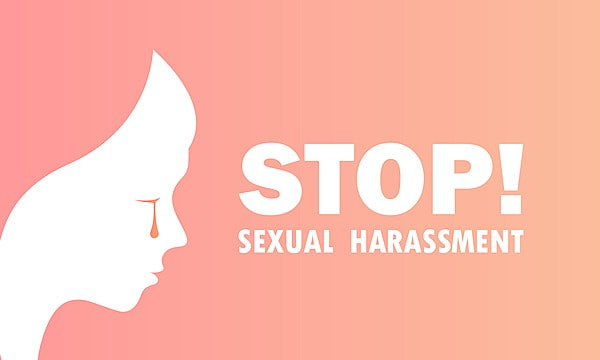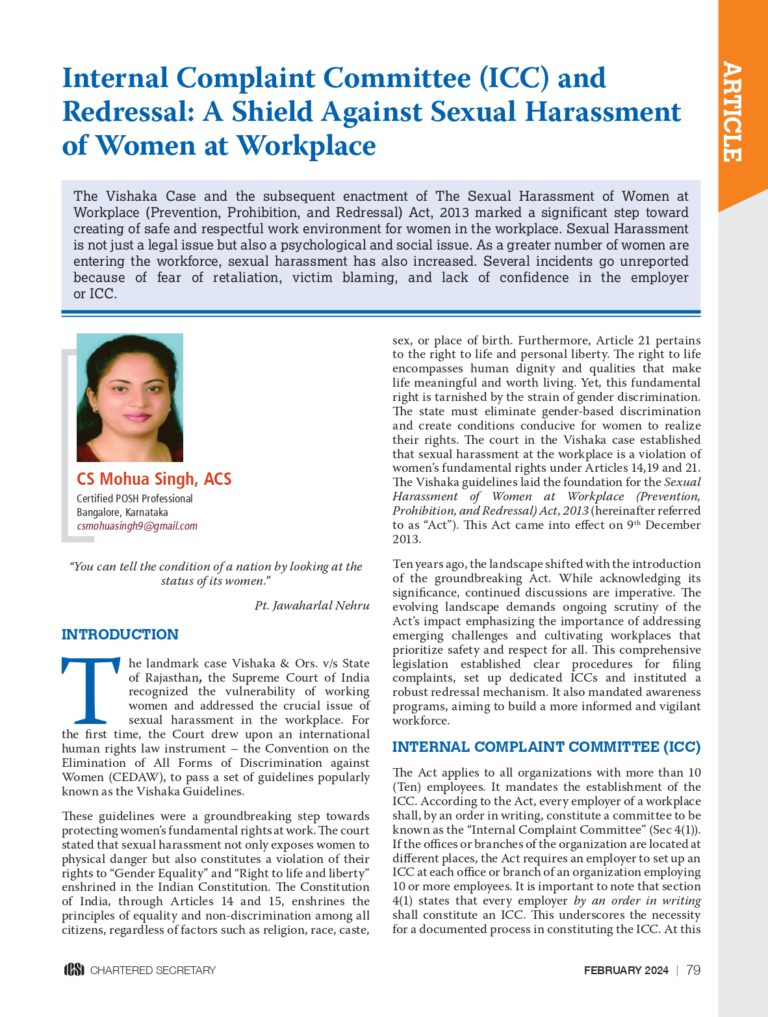The Sexual Harassment of Women at Workplace (Prevention, Prohibition and Redressal)(POSH) Act, 2013.
What is sexual harassment?
Sexual Harassment is a form of offensive behaviour that involves unwelcome advances, comments, or actions of a sexual nature that create an intimidating, hostile, or uncomfortable environment for an individual. It often involves disrespectful, coercive, or degrading behaviour based on a person’s gender or sexuality, and it can occur in various settings, such as workplaces, educational institutions, public spaces, or online platforms.
The Posh Act defines sexual harassment as follows:
“Sexual Harassment” includes any one or more of the following unwelcome acts or behaviour (whether directly or by implication) namely:
-
- physical contact and advances; or
-
- a demand or request for sexual favours; or
-
- making sexually coloured remarks; or
-
- showing pornography; or
-
- any other unwelcome physical, verbal or non-verbal conduct of a sexual nature.
Sexual Harassment may not always occur from the direction of management to employees but occur among the employees. This may occur in the form of general staffers such as clients or customers visiting the establishment – termed as third-party sexual harassment.
Sexual Harassment includes the following most common ways of harassment at the workplace:
Verbal harassment:
-
- Sexual Comments and Jokes.
-
- Using derogatory or sexually explicit language, slurs, or insults based on a person’s gender or sexual orientation.
-
- Using suggestive language, double meanings, or innuendos with sexual connotations in conversations or remarks, even if disguised as humour.
-
- Graphic sexual description, chatting of a sexual nature.
-
- Telephone calls with sexual tones.
Non-Verbal Harassment:
-
- Making explicit sexual gestures, such as lewd hand motions or suggestive body language.
-
- Prolonged and unwelcome staring or leering at someone’s body or specific body parts in a sexualized manner.
-
- Giving sexually suggestive gifts or objects with sexual connotations to someone without their consent.
-
- Physically blocking someone’s path or cornering them in a way that makes them feel trapped or unsafe
Visual Sexual Harassment
-
- Forcing someone to witness indecent exposure or sexual acts.
-
- Using explicit images or videos to intimidate or harass someone.
-
- Secretly taking photographs or videos of someone in a sexual or compromising situation without their knowledge or consent.
-
- Using technology to cyberbully or stalk someone with sexual content.
Physical Sexual Harassment
-
- Using hugs, handshakes, or other seemingly innocent physical greetings as a cover for sexual advances.
-
- Forcing physical contact under the guise of a friendly gesture.
-
- Creating a hostile environment through physical actions, such as repeatedly touching someone inappropriately, even without direct sexual contact.
Psychological Sexual Harassment
-
- Discrediting or manipulating an individual’s perception of the harassment, often by making them doubt their experience or feelings.
-
- Creating an environment where pervasive sexual comments, jokes, or behaviour make it difficult for employees to work comfortably.
-
- Critiquing or making fun of someone’s physical appearance in a sexual way.
-
- Isolating the victim by spreading rumours or alienating them from their colleagues.
In the case of Apparel Export Promotion Council v. A.K Chopra(1999), the Supreme Court enlarged the definition of sexual harassment and opined that physical contact is not the essential element of sexual harassment. The Supreme Court explained that “sexual harassment is a form of sex discrimination projected through unwelcome sexual advances, request for sexual favours and other verbal or physical conduct with sexual overtones, whether directly or by implication, particularly when submission to or rejection of such conduct by the female employee was capable of being used for affecting the employment of the female employee and unreasonably interfering with her work performance and had the effect of creating an intimidating or hostile work environment for her.”
Kinds of Sexual Harassment
Sexual Harassment can chiefly be classified into two categories:
1. Quid-Pro-Quo
Quid-Pro-Quo means ‘something for something’. Quid-pro-quo sexual harassment consists of two elements which are:
i. A demand for sexual favour, and
ii. The threat of adverse job consequences if the demand is refused.
In a typical situation of quid pro quo harassment, the respondent being a person in power, pressurizes the woman employee (usually a subordinate) for sexual favours in exchange for advancement in the workplace or threat of adverse employment action. Quid-pro-quo sexual harassment situations may also exist vis-à-vis a colleague of the same work.
2. Hostile Work Environment
Hostile work environment finds statutory reflection under section 2(n) read with section 3(2) of that 2013 Act. A hostile work environment means creating a hostile, intimidating, or offensive work environment to unreasonably interfere with a woman’s work performance or subjecting a woman to humiliating treatment likely to affect her health and safety.
It is important to remember that workplace sexual harassment is sexual and unwelcome, and the experience is subjective. It is the impact and not the intent that matter




